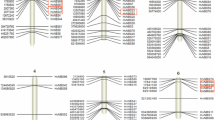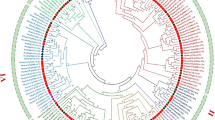Abstract
A complete set of candidate disease resistance ( R) genes encoding nucleotide-binding sites (NBSs) was identified in the genome sequence of japonica rice ( Oryza sativa L. var. Nipponbare). These putative R genes were characterized with respect to structural diversity, phylogenetic relationships and chromosomal distribution, and compared with those in Arabidopsis thaliana. We found 535 NBS-coding sequences, including 480 non-TIR (Toll/IL-1 receptor) NBS-LRR (Leucine Rich Repeat) genes. TIR NBS-LRR genes, which are common in A. thaliana, have not been identified in the rice genome. The number of non-TIR NBS-LRR genes in rice is 8.7 times higher than that in A. thaliana, and they account for about 1% of all of predicted ORFs in the rice genome. Some 76% of the NBS genes were located in 44 gene clusters or in 57 tandem arrays, and 16 apparent gene duplications were detected in these regions. Phylogenetic analyses based both NBS and N-terminal regions classified the genes into about 200 groups, but no deep clades were detected, in contrast to the two distinct clusters found in A. thaliana. The structural and genetic diversity that exists among NBS-LRR proteins in rice is remarkable, and suggests that diversifying selection has played an important role in the evolution of R genes in this agronomically important species. (Supplemental material is available online at http://gattaca.nju.edu.cn.)





Similar content being viewed by others
References
Bai J, Pennill LA, Ning J, Lee SW, Ramalingam J, Webb CR, Zhao B, Sun Q, Nelson JC, Leach JE, Hulbert SH (2002) Diversity in nucleotide binding site-leucine-rich repeat genes in cereals. Genome Res 12:1871–1884
Bailey TL, Elkan C (1995) The value of prior knowledge in discovering motifs with MEME. Proc Int Conf Intell Syst Mol Biol 3:21–29
Barclay AN (1999) Ig-like domains: Evolution from simple interaction molecules to sophisticated antigen recognition. Proc Natl Acad Sci USA 96:14672–4
Bergelson J, Kreitman M, Stahl E, Tian D (2001) Evolutionary dynamics of plant R -genes. Science 292:2281–2285
Bryan GT, Wu KS, Farrall L, Jia Y, Hershey HP, McAdams SA, Faulk KN, Donaldson GK, Tarchini R, Valent B (2000) A single amino acid difference distinguishes resistant and susceptible alleles of the rice BLAST resistance gene Pi-ta. Plant Cell 12:2033–46
Dangl JL, Jones JD (2001) Plant pathogens and integrated defence responses to infection. Nature 411:826–833
Dodds PN, Lawrence GJ, Ellis JG (2001) Six amino acid changes confined to the LRR beta-strand/beta-turn motif determine the difference between the P and Ps rust resistance specificities in flax. Plant Cell 13:163–178
Ellis JG, Lawrence GJ, Luck JE, Dodds PN (1999) Identification of regions in alleles of the flax rust resistance gene L that determine differences in gene-for-gene specificity. Plant Cell 11:495–506
Ellis J, Dodds P, Pryor T (2000) The generation of plant disease resistance gene specificities. Trends Plant Sci 5:373–379
Flor HH (1971) Current status of the gene-for-gene concept. Annu Rev Phytopathol 9:275–296
Goff SA, et al (2002) A draft sequence of the rice genome ( Oryza sativa L. ssp. japonica). Science 296:92–100
Gu Z, Cavalcanti A, Chen F-C, Bouman P, Li W-H (2002) Extent of gene duplication in the genomes of Drosophila, nematode, and yeast. Mol Biol Evol 19:256–262
Hammond-Kosack KE, Jones JD (1997) Plant disease resistance genes. Annu Rev Plant Physiol Plant Mol Biol 48:575–607
Holub E (2001) Arms race is ancient history in Arabidopsis, the wildflower. Nat Rev Genet 2:516–527
Hulbert SH, Webb CA, Smith SM, Sun Q (2001) Resistance gene complexes: evolution and utilization. Annu Rev Phytopathol 39:285–312
Jebannathirajah J, Peri S, Pandey A (2002) Toll and interleukin-1 receptor (TIR) domain-containing proteins in plants: a genomic perspective. Trends Plant Sci 7:388–391
Jia Y, McAdams S A, Bryan G T, Hershey H P, Valent B (2000) Direct interaction of resistance gene and avirulence gene products confers rice BLAST resistance. EMBO J 19:4004–4014
Kanazin V, Marek LF, Shoemaker RC (1996) Resistance gene analogs are conserved and clustered in soybean. Proc Natl Acad Sci USA 93 11746–750
Keen NT (1990) Gene-for-gene complementarity in plant-pathogen interactions. Annu Rev Genet 24:447–463
Kobe B, Kajava AV (2001) The leucine rich repeat as a protein recognition motif. Curr Opin Struct Biol 11:725–732
Leister D, Kurth J, Laurie DA, Yano M, Sasaki T, Devos K, Graner A, Schulze-Lefert P (1998) Rapid reorganization of resistance gene homologues in cereal genomes. Proc Natl Acad Sci USA 95:370–375
Lupas A, Van Dyke M, Stock J (1991) Predicting coiled coils from protein sequences. Science 252:1162–4
Meyers BC, Shen KA, Rohani P, Gaut BS, Michelmore RW (1998) Receptor-like genes in the major resistance locus of lettuce are subject to divergent selection. Plant Cell 11:1833–1846
Meyers BC, Dickerman AW, Michelmore RW, Sivaramakrishnan S, Sobral BW, Young ND (1999) Plant disease resistance genes encode members of an ancient and diverse protein family within the nucleotide-binding superfamily. Plant J 20:317–332
Meyers BC, Morgante M, Michelmore RW (2002) TIR-X and TIR-NBS proteins: two new families related to disease resistance TIR-NBS-LRR proteins encoded in Arabidopsis and other plant genomes. Plant J 32:77–92
Meyers BC, Kozik A, Griego A, Kuang H, Michelmore RW (2003) Genome-wide analysis of NBS-LRR-encoding genes in Arabidopsis. Plant Cell 15:809–834
Michèle H (2000) Hypersensitive response-related death. Plant Mol Biol 44:321–334
Michelmore RW, Meyers BC (1998) Clusters of resistance genes in plants evolve by divergent selection and a birth-and-death process. Genome Res 8:1113–30
Mondragon-Palomino M, Meyers BC, Michelmore RW, Gaut BS (2002) Patterns of positive selection in the complete NBS-LRR gene family of Arabidopsis thaliana. Genome Res 12:1305–1315
Noel L, Moores TL, van der Biezen EA, Parniske M, Daniels MJ, Parker JE, Jones JD (1999) Pronounced intraspecific haplotype divergence at the RPP5 complex disease resistance locus of Arabidopsis. Plant Cell 11:2099–2111
Pan Q, Liu Y-S, Budai-Hadrian O, Sela M, Carmel-Goren L, Zamir D,Fluhr R (2000) Comparative genetics of nucleotide binding site-leucine rich repeat resistance gene homologues in the genomes of two dicotyledons: tomato and Arabidopsis. Genetics 155:309–322
Parniske M, Hammond-Kosack KE, Golstein C, Thomas CM, Jones DA, Harrison K, Wulff BB, Jones JD (1997) Novel disease resistance specificities result from sequence exchange between tandemly repeated genes at the Cf-4/9 locus of tomato. Cell 91:821–832
Richly E, Kurth J, Leister D (2002) Mode of amplification and reorganization of resistance genes during recent Arabidopsis thaliana evolution. Mol Biol Evol 19:76–84
Schultz J, Milpetz F, Bork P, Ponting CP (1998) SMART, a simple modular architecture research tool: identification of signaling domains. Proc Natl Acad Sci USA 95:5857–5864
Swofford D (2000) PAUP*: Phylogenetic Analysis Using Parsimony. Sinauer, Sunderland, Mass.
Thompson JD, Higgins DG, Gibson TJ (1994) CLUSTAL W: improving the sensitivity of progressive multiple sequence alignment through sequence weighting, position-specific gap penalties and weight matrix choice. Nucleic Acids Res 22:4673–4680
Tian D, Akashi H, Stahl E, Bergelson J, Kreitman M (2002) Signature of balancing selection in Arabidopsis. Proc Natl Acad Sci USA 99:11525–11530
Tian D, Shaw B, Chen J, Kreitman M, Bergelson J (2003) Fitness cost of R -gene mediated resistance in Arabidopsis thaliana. Nature 424:74–77
Wang ZX, Yano M, Yamanouchi U, Iwamoto M, Monna L, Hayasaka H, Katayose Y, Sasaki T (1999) The Pib gene for rice BLAST resistance belongs to the nucleotide binding and leucine-rich repeat class of plant disease resistance genes. Plant J 19:55–64
Yu J, et al (2002) A draft sequence of the rice genome ( Oryza sativa L. ssp. Indica). Science 296:79-92
Acknowledgements
We thank J. J. Emerson for useful discussions, the Japan Society for the Promotion of Science for Young Scientists for the award of Research Fellowships to H. A., Nanjing University for the generous initial funding of D.T., and IBM for a SUR grant
Author information
Authors and Affiliations
Corresponding author
Additional information
Communicated by R. Hagemann
The first three authors contributed equally to this work
Rights and permissions
About this article
Cite this article
Zhou, T., Wang, Y., Chen, JQ. et al. Genome-wide identification of NBS genes in japonica rice reveals significant expansion of divergent non-TIR NBS-LRR genes. Mol Genet Genomics 271, 402–415 (2004). https://doi.org/10.1007/s00438-004-0990-z
Received:
Accepted:
Published:
Issue Date:
DOI: https://doi.org/10.1007/s00438-004-0990-z




